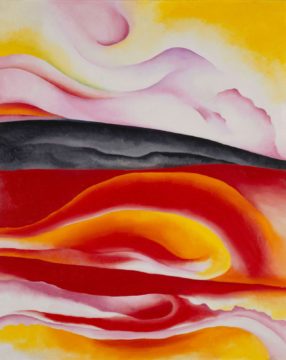Roxana Robinson at The New Yorker:
 The works carry a metaphysical meaning, as well as a geographical one. With the skulls and antlers, bones and shells, O’Keeffe creates a secular iconography. For her, these subjects did not represent death but something vital and lasting. A bone found in the desert is like a shell found on the beach: both are forms defined by function, both are beautiful and enduring evidence of life. O’Keeffe’s images and juxtapositions are mysterious, but she wasn’t a member of the Surrealist movement, which deliberately juxtaposed objects without connections to one another. Her intention was quite different: these objects have a deep connection—one that we recognize on an intuitive level. “Pelvis with the Distance,” from 1943, shows a smooth, white bone, all curves and slopes and openings. It is suspended, high in the air, above a line of low, undulant blue hills. This physical juxtaposition—the celestial locus of the bone, the earth-hugging horizon below—creates a majestic sweep of space. O’Keeffe places the viewer aloft, level with the bone, high up in the empyrean. The supernatural height, the mystery, the hallucinatory beauty of the object—all combine to create a sense of the sublime.
The works carry a metaphysical meaning, as well as a geographical one. With the skulls and antlers, bones and shells, O’Keeffe creates a secular iconography. For her, these subjects did not represent death but something vital and lasting. A bone found in the desert is like a shell found on the beach: both are forms defined by function, both are beautiful and enduring evidence of life. O’Keeffe’s images and juxtapositions are mysterious, but she wasn’t a member of the Surrealist movement, which deliberately juxtaposed objects without connections to one another. Her intention was quite different: these objects have a deep connection—one that we recognize on an intuitive level. “Pelvis with the Distance,” from 1943, shows a smooth, white bone, all curves and slopes and openings. It is suspended, high in the air, above a line of low, undulant blue hills. This physical juxtaposition—the celestial locus of the bone, the earth-hugging horizon below—creates a majestic sweep of space. O’Keeffe places the viewer aloft, level with the bone, high up in the empyrean. The supernatural height, the mystery, the hallucinatory beauty of the object—all combine to create a sense of the sublime.
more here.
